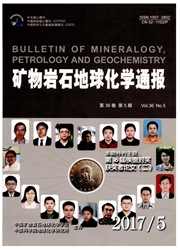

 中文摘要:
中文摘要:
本文利用显微测温学和激光喇曼光谱方法,研究了661铀矿床与铀成矿作用有关的脉石矿物(萤石、石英和方解石)中的流体包裹体。结果表明,成矿早期脉石矿物中的流体包裹体均一温度为130250℃,盐度为1.65%3.44%(NaCl),密度为0.811.01 g/cm3;成矿晚期流体包裹体的均一温度为95150℃,盐度为1.48%1.64%(NaCl),密度为0.880.96g/cm3。这些资料揭示出该矿床的成矿流体为中低温、低盐度、中等密度热液。激光喇曼光谱气相成分分析主要为H2O,未见其他气体成分。明显不同于岩浆热液矿床中的包裹体特征及其成矿流体的性质,结合该矿床成矿地质特征、氧同位素及区域铀矿床成矿物化条件等资料,进一步分析推断成矿流体的水可能主要来自大气降水。
 英文摘要:
英文摘要:
The No.661 uranium deposit occurs in rhyolite of the Jiuliping Formation,the eastern part of Ganhang uranium belt,Zhejiang Province.The microthermometry and laser Raman spectroscopy analyses of fluid inclusions in fluorite,quartz and calcite associated with uranium mineralization were used to characterize chemical evolution of the ore fluids at the No.661 uranium deposit.Two types of inclusions,liquid and liquid-vapor inclusions,were observed in these minerals.The homogenization temperatures of the liquid-vapor inclusions in these minerals from early stage to late stage range from 130 to 250℃ and 95 to 150℃,respectively.The calculated salinities and densities of fluids range from 1.65% to 3.44%,1.48% to 1.64%(NaCl) equivalent and 0.81 to 1.01 g/cm3,0.88 to 0.96 g/cm3,respectively.Laser Raman microspectrometry showed that gaseous compositions of the liquid-vapor inclusions are mainly composed of H2O.The fluid inclusion data indicated that the ore-forming fluid of the No.661 uranium deposit could be characterized by moderate to low temperature,low salinity and moderate density.Combined with oxygen isotopic composition and physicochemical conditions in regional uranium deposits,we concluded that the fluid is of deep circulating meteoric origin.
 同期刊论文项目
同期刊论文项目
 同项目期刊论文
同项目期刊论文
 U-Pb zircon ages, geochemical and Sr-Nd-Pb isotopic constraints on the dating and origin of intrusiv
U-Pb zircon ages, geochemical and Sr-Nd-Pb isotopic constraints on the dating and origin of intrusiv Mantle-derived gaseous components in ore-forming fluids of the Xiangshan uranium deposit, Jiangxi pr
Mantle-derived gaseous components in ore-forming fluids of the Xiangshan uranium deposit, Jiangxi pr U-Pb zircon age, geochemical and Sr-Nd-Pb-Hf isotopic constraints on age and origin of alkaline intr
U-Pb zircon age, geochemical and Sr-Nd-Pb-Hf isotopic constraints on age and origin of alkaline intr Uranium metallogenesis in South China and its relationship to crustal extension during the Cretaceou
Uranium metallogenesis in South China and its relationship to crustal extension during the Cretaceou Zircon U-Pb geochronology and major, trace elemental and Sr-Nd-Pb isotopic geochemistry of mafic dyk
Zircon U-Pb geochronology and major, trace elemental and Sr-Nd-Pb isotopic geochemistry of mafic dyk REE Geochemistry of the Cretaceous lignite from Wulantuga Germanium Deposit, Inner Mongolia, Northea
REE Geochemistry of the Cretaceous lignite from Wulantuga Germanium Deposit, Inner Mongolia, Northea Sediment-hosted gold deposits in Guizhou, China: Products of wall-rock sulfidation by deep crustal f
Sediment-hosted gold deposits in Guizhou, China: Products of wall-rock sulfidation by deep crustal f 期刊信息
期刊信息
